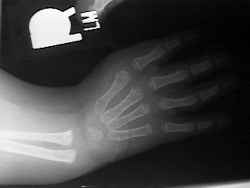- Discussion:
- presents w/ differing degrees of shortening (or absence) of radius, carpal bones, and radial rays (including thumb);
- bowing of the ulna may contribut to the deformity;
- elbow may have fixed extension contracture or may have deficit of active motion;
- patients may do well with no special treatment;
- they may develop side to side pinch between adjacent digits;
- handling of large objects may be a problem, but some children will be able to grasp objects between the hand and the arm;
- Associated Disorders:
- VATER association;
- vertebral anomalies, anal atresia, tracheo-esophageal fistula, radial and, renal anomalies;
- cardiac anomalies (atrial septal defect and absent radius = Holt Oram);
- pan-cytopenia or thrombocytopenia - absent radius (TAR Syndrome);
- Exam:
- extremity shortening;
- radial and volar angulation;
- motion of wrist and elbow;
- pts w/ a stiff elbow may prefer to keep hand in the radial deviated position, because the hand is in a better position for feeding;
- decreased grip strength;
- ability to grasp small and large objects;
- hypoplasia
- Classification:
- Type I:
- elbow and proximal radius is normal;
- distal radial physis is deficient and radius is shortened;
- radial clubbing due to hypoplastic radial carpi;
- soft tissue contractures may limit motion;
- thumb may show variable degree of hypoplasia;
- treatment: soft tissue release and transfer of the ECRL to the ECU;
- Type II:
- hypoplastic radius (more than 1-2 cm shorter than opposite side);
- wrist is unstable and is radially deviated;
- may be amenable to radial lengthening;
- Type III:
- parital absence of the radius;
- IV:
- most common type;
- complete absence of the radius, and often there is absence of the radial carpi and first and second metacarpal;
- elbow may be unstable or stiff;
- there are severe soft tissue contractures on the radial (and volar) side of the wrist;
- these deformities increase during growth;
- Non Operative Treatment:
- in infants, splints are difficult to apply, and therefore initial treatment involves wrist and elbow ROM and stretching the radial and flexion
deformities;
- serial casts are used to stretch tight structures on radial side in order to achieve longitudinal alignment;
- serial cast will not correct carpal malalignment;
- Surgical Treatment Options:
- considerations:
- historically reconstructive procedures on the wrist were avoided w/ a stiff elbow, however, in many cases, the PT can increase elbow
ROM (which allows surgery to procede);
- radialization:
- the head of the ulna is brought under the radial carpal bones, and the hand is fixed in ulnar deviation w/ a K wire;
- procedure includes release of tight radial soft tissue structures along with possible tendon transfers to from the radial to ulnar side of the
wrist;
- as would be expected, worse results are seen with the more severe cases;
- centralization technique:
- primary addresses radial angulatory deformity and may improve wrist motion;
- this attempts to re-align the 3rd metacarpal at right angles to the plane of the distal ulnar epiphyseal plate;
- in most cases centralization should be performed prior to one year of age;
- centralization may be performed along w/ radial soft tissue release and as well as transfer of flexor and extensor carpi radialis tendons
to the ulnar side;
- caution:
- the procedure is contra-indicated w/ a stiff elbow (elbow needs to flex to 90 deg);
- technique:
- performed through longitudinal dorsal radial incision;
- distal ulna is squared off and inserted into a rectangular notch on radial side of the carpus;
- removal of carpal bones effects a closing wedge osteotomy;
- resection of carpi relies on formation of fibrous pseudarthrosis to provide wrist stability;
- carpi need not be resected if procedure is performed prior to age 12 months;
- w/ significant ulnar bowing, ulnar osteotomy can be carried out as well;
- disadvantages:
- late results show variable success;
- resection of proximal central carpus may result in ulno-carpal fusion, with resultant wrist stiffness;
- Ulnar Lengthening:
- bowing of the ulna is usually not progressive;
- may be considered following centralization if bowing is severe
Radial club hand. A continuing study of sixty-eight patients with one hundred and seventeen club hands.
Opening versus closing wedge osteotomy of the curved ulna in radial clubhand.


